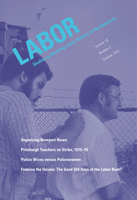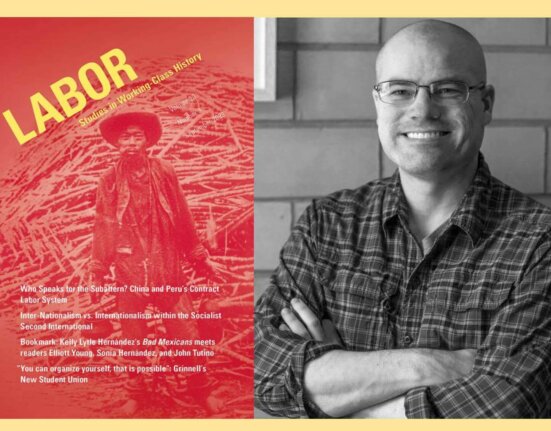In This Issue
The Common Verse
- Kathleen Walker-Anderson, “The House That Dow Built“
LAWCHA Watch
- Shelton Stromquist and Immanuel Ness, “Rights, Solidarity, and Justice: LAWCHA’s National Conference“
Articles
- David Witwer, “The Heyday of the Labor Beat”
In this article Witwer describes the emergence in the 1930s of a group of reporters employed by the mainstream media whose careers centered on covering labor. They claimed a distinct approach to writing about working Americans and organized labor. The most prominent early member of the “labor beat,” Louis Stark, promoted a model of journalism that fostered a better understanding of unions and workers by the general public. The labor beat expanded in the 1930s in response to turbulent strike waves and the dramatic growth of unions. Labor beat reporters developed sources within the working-class community and union leadership, from local officials to the top executives of the labor federations. While many newspaper publishers held antipathetic views of organized labor in this era, they found it in their interest to employ labor beat reporters because it bolstered their circulation and provided a chance to wield political influence with working-class voters. By the 1940s and 1950s, another wing of the labor beat emerged that focused on exposing union corruption and left-wing influence on organized labor. Pieces by Westbrook Pegler and Victor Riesel were prominent examples of this kind of journalism, and the influence of this exposé brand of journalism on public opinion regarding unions undercut the initial promise of the labor beat.
- Lane Windham, “Signing Up in the Shipyard: Organizing Newport News and Reinterpreting the 1970s”
Through a case study of the largest National Labor Relations Board (NLRB) election in the 1970s, the author challenges the dominant historical narrative that the entire decade was a period of decline for worker militancy. Instead, Lane Windham argues that workers were steadily forming unions in the private sector throughout the 1970s and their success rates dropped when they were met by markedly increased employer resistance. The author examines the successful effort by nineteen thousand workers at the Newport News shipyard in Virginia to win a NLRB election in 1978. The workers waged an eighty-two-day strike when the company, Tenneco Inc., would not honor its obligation to a union contract. The governor’s guardsmen met workers on the picket lines and the city police stormed the union hall, beating strikers with abandon. The workforce was half white, half black, and included many women. Windham argues that the civil rights and women’s movements energized, rather than enervated, the unionization efforts. This case study highlights the 1970s emerging corporate pattern of attacking workers’ organizing efforts.
- David Brody, “David Montgomery, Field Builder“
- Jon Shelton, “Against the Public: The Pittsburgh Teachers Strike of 1975 – 1976 and the Crisis of the Labor-Liberal Coalition”
In this article, Jon Shelton uses a two-month-long teacher strike in Pittsburgh as a case study to trace the trajectory of the conservative turn in American politics during the 1970s. Immediately coming on the heels of the New York City fiscal crisis in 1975, the Pittsburgh strike raised concerns regarding the city’s fiscal position and its ability to control its labor force. When the strike began, many criticized the teachers for walking off the job but still supported the teachers’ goals, arguing that adequate teacher salaries were vital, particularly following a year of double-digit inflation. As the strike continued and the union leaders’ actions were criminalized, however, the public came to believe that teachers had abrogated their duties as inculcators of moral values. Though Pennsylvania had passed the most far-reaching public-sector labor law in 1970, the Pittsburgh strike catalyzed the governor to form a new commission with the potential to roll back the gains of the law. Shelton uses records of this commission to show how the basic political assumptions in Pennsylvania about the role of the state and the importance of labor unions to the democratic process shifted immensely during the course of the 1970s.
- Megan Adams, ““The Feminine Arm of the Law”: Police Wives, Policewomen, and Gender Politics in the Chicago Police Department, 1950 – 1984”
In the late twentieth century, rank-and-file members of the Chicago police struggled to organize civil rights and labor protests against the city and police department. Police wives joined them in this effort and, because they were not subject to department rules or discipline, often served as proxies for the police during workplace disputes. Developing their own series of organizations, police wives staged protests and ran petition drives in support of their husbands’ initiatives. They also focused on improved police safety—an effort they said would keep police wives from becoming police widows. When Chicago policewomen went out on patrol with policemen for the first time in 1974, Chicago’s police wives rallied to oppose gender equality for policewomen. Arguing that policewomen posed a safety hazard to policemen on the job, police wives also feared that the allure of policewomen would destroy their marriages. As defenders of male privilege in the police department, police wives supported a sex-segregated workplace where policewomen did their jobs as “mothers.” At the same time, they demanded an equal voice in police department politics by drawing on their status and power as wives.







